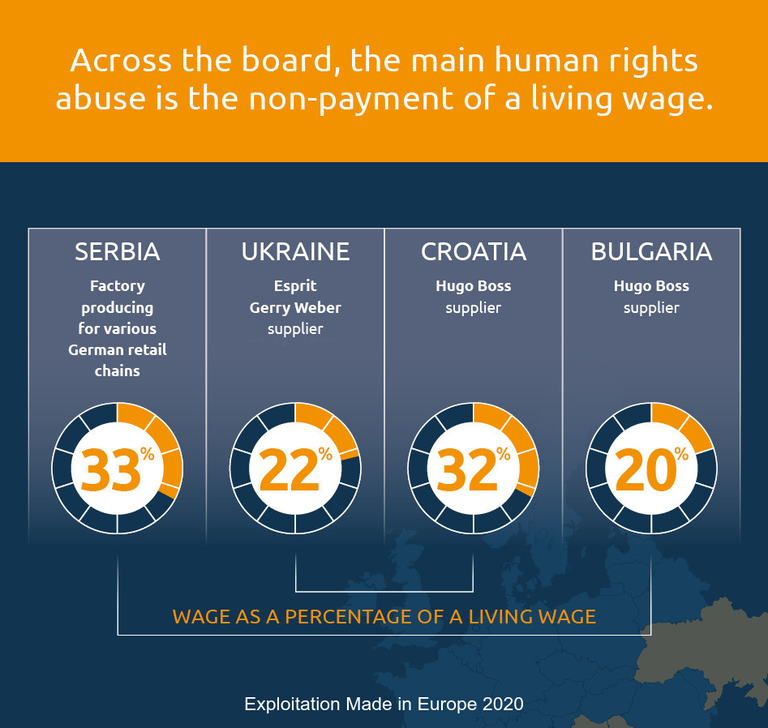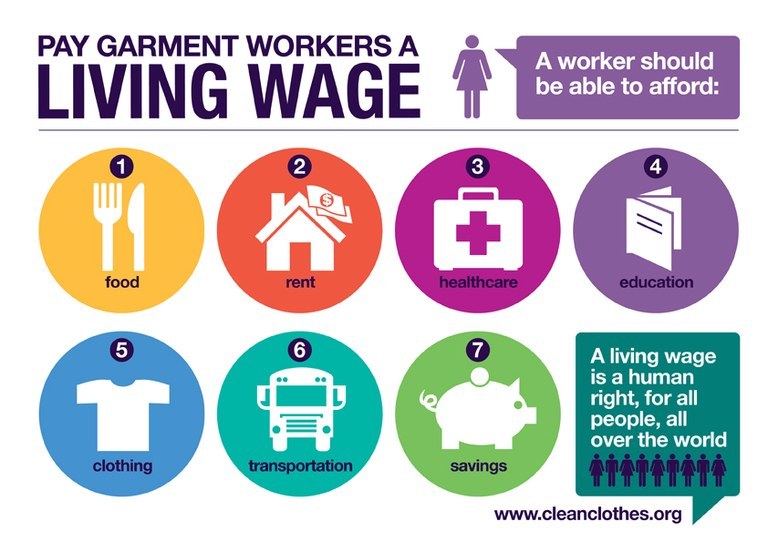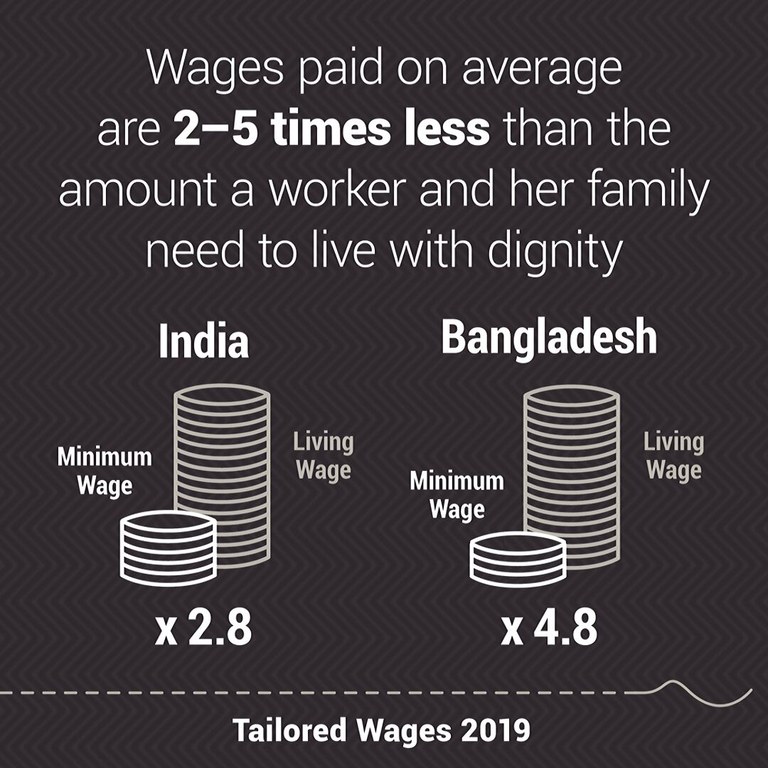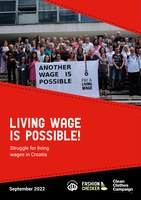
The problem
The global garment industry has doubled over the past 15 years and is powered by an estimated 60 million-strong workforce. The deprivation that the vast majority of these workers and their families face on a daily basis stands in stark contrast with the huge profits reported annually by global fashion brands.
Workers’ wages represent only a fraction of what consumers pay for the clothes because of deep-rooted structural power dynamics. A well-known example is the national kit of the England football team at the 2018 World Cup, embellished with a well-known sportswear brand logo and the most expensive England kit ever. They were sold to fans for as much as €180 – while the workers in Bangladesh who made them were earning less than €2 per day.
UN Guiding Principles on Business and Human Rights clearly state the role and responsibilities of businesses to respect the human right to fair wages. This responsibility “exists independently of States’ abilities and/or willingness to fulfil their own human rights obligations ... And it exists over and above compliance with national laws and regulations protecting human rights.” In other words, in cases where legal minimum wages fail to meet the minimum subsistence level (living wage) for workers in production countries – businesses have an obligation to remedy state failures.
Yet our ongoing research shows that no major brand can prove all workers in their supply chain earn a living wage. The same holds for fast fashion, luxury brands and worker apparel alike. No garment or sportswear company recognises that brand business practices have a direct effect on workers’ wages, leaving millions of workers deprived of not only wages but sleep, access to health care, safe transport, the ability to live with loved ones, adequate food, education, even time poverty from needing to work extra hours. The financial difference fair business practice would have for brands is minuscule compared to the difference fair wages would have on workers' lives.
The right to a living wage has been recognised by the Council of Europe and by the UN in the Universal Declaration of Human Rights, among others, but it is not respected in global production supply chains, even where legally set minimum wages are in place.





What we do
In order to reach a living wage, companies have to commit to fairer purchasing practices. If the solution rests on the factories and production country government policies then brands will always relocate to cheaper regions. Only when brands commit to paying more for orders can factories properly cover the costs of production, including labour.
Our work revolves around asking companies to use living wage benchmarks when calculating order prices. By putting a figure on the living wage, the labour cost can be calculated and embedded into pricing breakdowns, and companies can use this to be sure that suppliers are receiving enough to pay a living wage. If enough companies do this, production-country governments are given a clear signal that putting up the minimum wage to a living-wage level will not risk loss of business.
Living wage benchmarks
The Clean Clothes Campaign is part of the Asia Floor Wage Alliance, an alliance of Asian trade unions and labour groups, which has calculated a living wage formula for Asia. We feel this figure and methodology is the most robust, independent calculation for a living wage currently available, and is a vital tool in benchmarking what companies and governments should be aiming to achieve in terms of actual wage figures for workers. It is calculated based on some key assumptions that we believe must always be central to a living wage:
• A living wage is always a family wage. In most production countries, the pension and insurance schemes are not sufficient and public care services are often absent. A genuine living wage must therefore take that into account and at least partially cover the basic needs of unpaid caregivers in the household.
• A living wage must allow for savings. Without this, workers remain in a vulnerable situation, are not able to make mid- and long-term plans in their lives and are at risk of ending up in debt when additional unforeseen financial expenditure is needed.
• A living wage has to put a floor, not a ceiling, on wage payment and secure a minimum income for all workers. Ideally, a living wage should have a regional approach so as not to increase wage competition between countries, instead increasing the base wage level for all workers.
Freedom of Association
The commitment to a real living wage benchmark from companies also opens up space in wage negotiations between workers and factory owners. Currently, factory owners will say they have no choice but to keep wages low due to the low prices paid by buyers. In many cases this means that workers are under threat of losing their jobs or risk physical harm if they ask for higher wages. But if unions or worker groups know that brands being produced in their factory have committed to a specified living wage figure, these negotiations are opened up, and a living wage becomes a possibility.
Background
Poverty pay is one of the most pressing issues for workers worldwide, and it is embedded systemically in the global garment and sportswear industries. Companies have relied for decades on this system of poverty pay and exploitation, justifying the outsourcing of cheaply paid assembly work with the need to remain competitive in the global market and to offer cheaper prices to consumers.
Governments have kept minimum wages low under pressure from brands and retailers in a bid to create jobs and provide an economic boost to their state economies.
As a result, minimum wage, where it exists as a legally binding standard, is not the same as a living wage. What the minimum wage amounts to differs per country, but in almost all production countries, it is far from sufficient to provide for workers’ and their families’ basic needs. For instance, the Stitched Up report published by Clean Clothes Campaign in 2017 showed that there was a large gap between the legal minimum wages in Eastern/South-Eastern Europe and Turkey and what a worker would actually need to provide for themselves and their family.
Being paid poverty wages forces workers to work long hours to earn overtime or bonuses. They cannot risk refusing work due to unsafe working conditions, and they cannot take time off when they are ill. Workers often have to rely on loans to make ends meet and have no savings. If they find themselves out of work or faced with unexpected expenses, they are thrown into deep poverty.
There’s a host of related problems, such as poor housing, poor nourishment, inadequate access to health care, the risk of child labour, occupational accidents and violence against women.
Latest news on living wages
-
April 24, 2024
Remembering the Rana Plaza collapse
Today, we commemorate that eleven years ago 1,138 people lost their lives in the collapse of the Rana Plaza building in Bangladesh. Our thoughts are with the people who lost loved ones in this tragedy and with every worker who lived through it. We will keep on fighting side by side with garment workers' unions to make clear that workers’ lives are not a commodity and can not be treated as disposable.
-
April 17, 2024
11 years since the Rana Plaza collapse factories are safer but the root causes of tragedy persist
24 April 2024 will mark the 11th anniversary of the fashion industry’s worst tragedy: the collapse of the Rana Plaza building, killing 1,138 people. The catastrophic death and injury toll was caused by a deadly mix of fashion brands ignoring dangerous factory conditions, poverty wages, and centrally, constraints on workers’ ability to organise collectively. While unprecedented progress has been made to make factories safer, the brutal crackdown on workers’ rights still unfolding in response to protests to increase the minimum wage has shown that apparel brands producing in Bangladesh are still failing to ensure that the basic rights of their workers are respected.
-
April 10, 2024
Sri Lankan workers continue two-months long strike for decent wages, while brands fail to take sufficient action
On 10 February 2024, workers of the Sumithra Hasalaka factory in Sri Lanka organised by the Free Trade Zones & General Services Employees Union (FTZ & GSEU) startedstriking for a wage offer that meets their cost of living. Two months on, these brave workers’ strike continues in the face of harassment and intimidation, financial hardship, and during the most important family holiday of the year, the Sinhala and Tamil new year. International brands sourcing from the factory group have taken insufficient action to ensure their suppliertreatsworkers better.
-
February 16, 2024
Solidarity with striking garment workers at Sumithra Hasalaka, Sri Lanka!
Around 300 members of the Free Trade Zones & General Services Employees Union (FTZ & GSEU) at the Sumithra Hasalaka factory in Sri Lanka, have been out on strike since Saturday 10th February 2024.
1 - 4 of 85 Results
Latest resources on living wages
-
September 13, 2022
Living Wage is Possible: Struggle for living wages in Croatia (2022)
The increased interest in the subject of living wage in Croatia came in mid-2021, a new method of calculating a living wage for Croatia was presented at the round table “Europe Floor Wage – a living wage is a human right”. The round table also marked the official start of the campaign for a living wage in Croatia. The Coalition for a Living Wage was launched, bringing together several civil society organisations - Pariter, the Centre for Peace Studies, the House of Human Rights, the Base for Workers’ Initiative and Democratization (BRID), Fashion Revolution Croatia, the Centre for Education Counselling and Research (CESI), then the Regional Industrial Union and the Independent Workers' Union of Croatia.
-
July 30, 2022
The Europe Floor Wage - updating the benchmark to 2021
Background paper - updating wage benchmarks, taking into account inflation and cost of living increases.
-
July 13, 2022
A LIVING WAGE IS A HUMAN RIGHT - A proposal for Italy, for the fashion industry and beyond
In this report we specifically address the issue of wages as the first, but not the only, urgent issue we need to act on in order to tackle the problem of in-work poverty and inequality in Italy, starting from the fashion supply chains. The concept of wage we are referring to is the floor living wage adopted by the Clean Clothes Campaign, which can be defined as the value of the net basic wage able to guarantee the worker and his/her family the satisfaction of basic needs and decent living conditions. The net basic pay is calculated without overtime bonuses, before incentives and allowances, and after taxes, taking into account only monetary disbursements.
-
June 16, 2022
Turkey's garment industry profile
1,5 million workers in Turkey make garments for many global fashion brands, including: Adidas, Banana Republic, Benetton, Boohoo, C&A, Esprit, GAP, G-star, Hugo Boss, H&M, Inditex – Zara, Levi’s, Marks & Spencer, Next, Nike, Puma, Primark, Urban Outfitters, and VF. The top five export destinations for clothing made in Turkey are Germany, Spain, UK, Netherlands and France. Despite the big-name brands these workers produce for, new research shows that garment workers earn poverty pay which leaves them struggling to survive, highlighting the inadequacy of the legal minimum wage.
-
January 6, 2022
Do Dutch Garment Companies Guarantee A Living Wage In Their Supply Chains?
A position paper on (the lack of) progress on Living Wages and Transparency within the AGT and the urgent need for mandatory HRDD legislation
-
July 19, 2021
Still Un(der)paid
The crisis is far from over for garment workers during the pandemic. This Clean Clothes Campaign research from July 2021 shows that garment workers globally are owed 11.85 billion USD in unpaid income and severance from March 2020 to March 2021.
-
May 6, 2021
CCC statement on the report of the rapporteurs of the EP’s Committee on Employment and Social Affairs on the proposal for a directive on adequate minimum wages in the European Union
The Clean Clothes Campaign in May 2021 sent this statement welcoming the initiative of the EU Commission and the Committee for Employment and Social Affairs of the EU parliament “to ensure both that minimum wages are set at adequate and fair level and that workers have access to minimum wage protection”. The 35 Million garment workers worldwide – mostly women – are typical statutory minimum wage earners. This includes almost 1 Million garment workers in Central East-, East- and South East EU Member States. One important criterion for the sourcing decisions of fashion brands and retailers is the statutory minimum wages of potential sourcing countries. Brands and fashion retailers look for the countries with the lowest statutory minimum wages. Among them are many countries beyond the „iron wage curtain“ within Europe.
-
September 23, 2020
Out of the shadows: A spotlight on exploitation in the fashion industry
Our new report brings the data from the Fashion Checker transparency tool to life, detailing the stark contrast between fashion brands' claims and the reality of their supply chains.
1 - 8 of 23 Results












